Your Guide to the Captain Cook Snorkel Tour
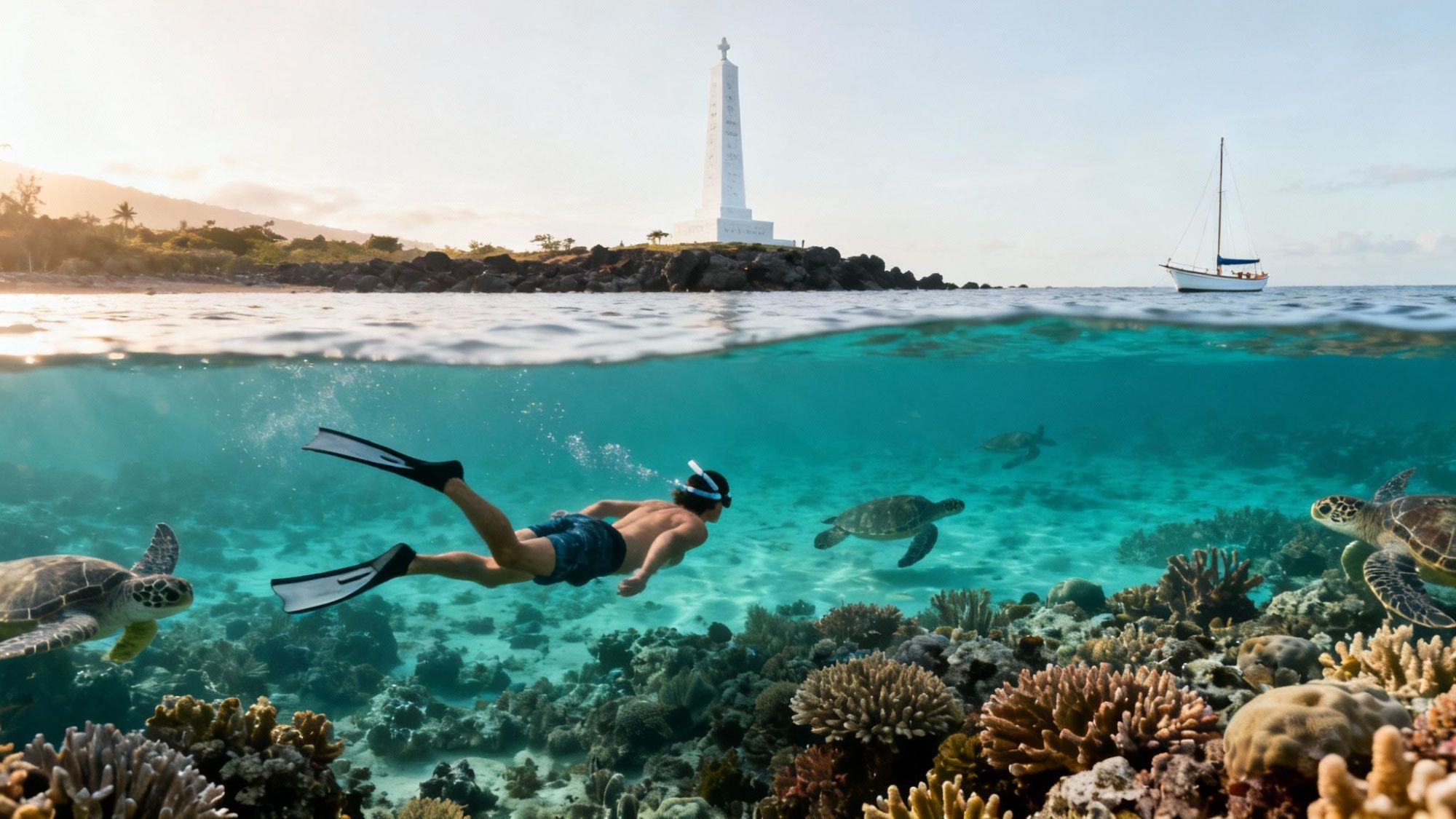
A Captain Cook snorkel tour is one of those signature Big Island adventures. It’s a perfect mix of world-class snorkeling in the protected waters of Kealakekua Bay and a fascinating dive into Hawaiian history. This isn't just a boat trip; it’s an immersive experience that takes you right into a pristine marine sanctuary, famous for its crystal-clear water, vibrant reefs, and the dramatic story of Captain James Cook's arrival back in 1779.
Your Adventure to Historic Kealakekua Bay Starts Here
Imagine gliding across turquoise water toward a bay where history and nature literally collide. This guide breaks down everything you need to know about the Captain Cook snorkel tour, an experience that’s so much more than just a swim. Think of it as a journey into an untouched underwater world and a step back to one of Hawaii's most important historical sites.
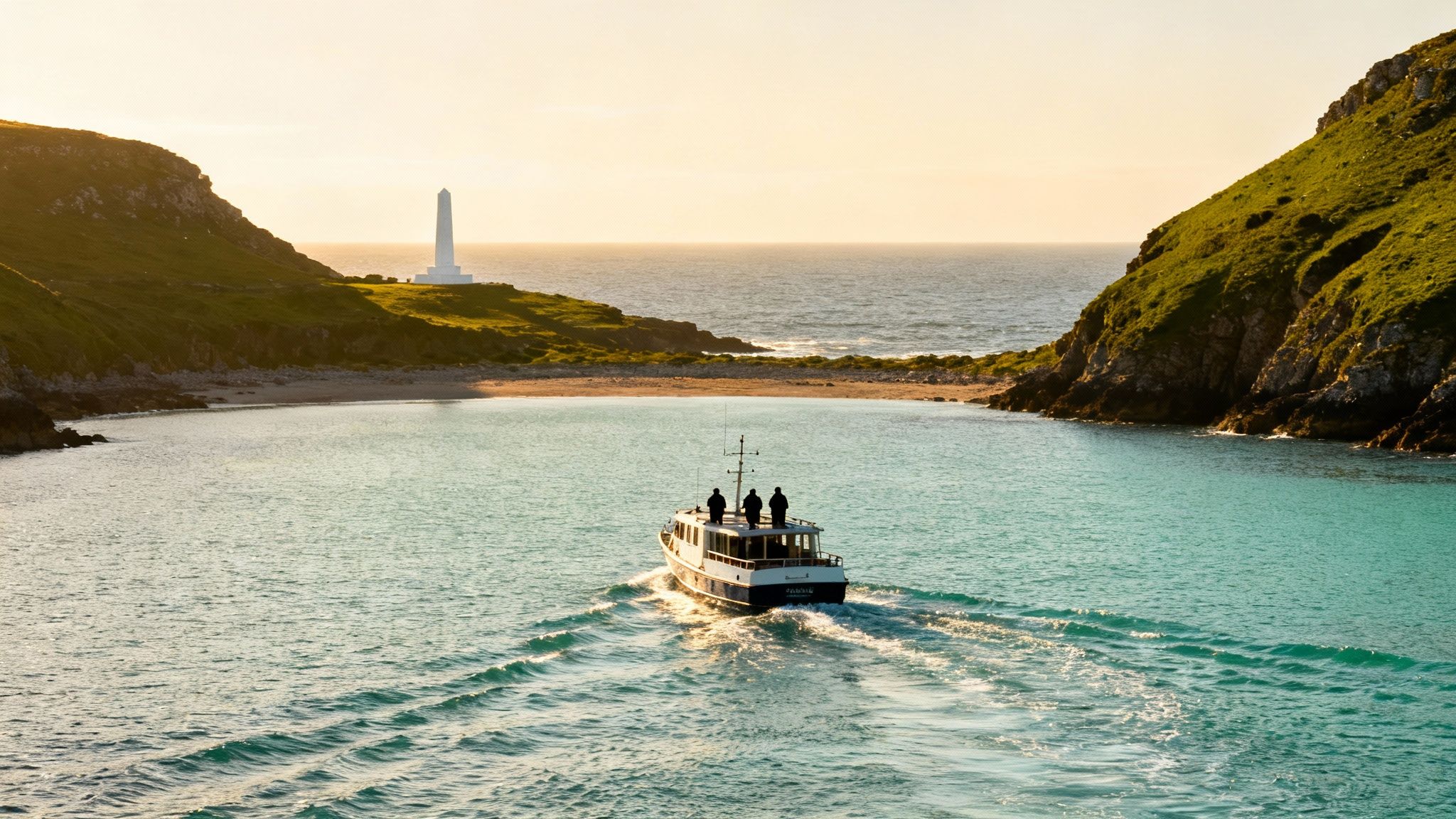
We'll get into why this protected marine sanctuary has some of the clearest water and most abundant sea life on the Big Island. But more than that, we’ll connect the dots between the incredible coral gardens you'll be swimming over and the fateful encounter that took place in this very bay.
More Than Just Snorkeling
This tour is a unique blend of fun and learning. While the main event is definitely the incredible underwater ecosystem, the historical backstory is what makes the whole day so special. It’s like visiting a natural museum where the exhibits are living coral reefs and the gallery walls hold stories of ancient Hawaiian culture.
That combination is what really sets this trip apart from any other snorkel spot. The destination, Kealakekua Bay, is the undisputed star, protected as a Marine Life Conservation District. This special status is the reason its ecosystem is so healthy, offering you an authentic peek into Hawaii's precious natural treasures.
Kealakekua Bay isn’t just a beautiful spot; it’s a living historical landmark. Floating in these waters, you are snorkeling over the very reefs that witnessed one of the most pivotal moments in Hawaiian-Western contact history.
What Makes This Bay So Special?
The bay's geography has a lot to do with its magic. It's naturally sheltered from big ocean swells, which creates exceptionally calm and clear water—perfect for snorkelers of any skill level, from total beginners to seasoned pros. This protection has allowed one of Hawaii's most robust reef systems to flourish.
On your trip, you'll likely run into some incredible locals:
- Spinner Dolphins (Naiʻa): You can often spot them playing in the bay as they rest during the day.
- Hawaiian Green Sea Turtles (Honu): Seeing these guys glide gracefully over the reef is a common and always awe-inspiring sight.
- A Kaleidoscope of Reef Fish: Keep an eye out for bright yellow tangs and Hawaii's state fish, the humuhumunukunukuāpuaʻa.
This article is your all-in-one resource for planning the perfect trip, from picking the right boat to understanding the powerful history that makes this adventure unforgettable. For even more info, check out our comprehensive guide to the Kealakekua Bay snorkeling tour. Get ready to find out why this experience is a must-do for anyone visiting Kona.
The Rich History Behind Your Snorkel Adventure
As your boat drops anchor in the calm, protected waters of Kealakekua Bay, you’re floating above more than just a world-class snorkel spot—you're at a profound cultural landmark. A Captain Cook snorkel tour isn't just an outing; it's a journey back in time. This isn't just about seeing fish; it's about understanding the powerful story that unfolded right where you're swimming.
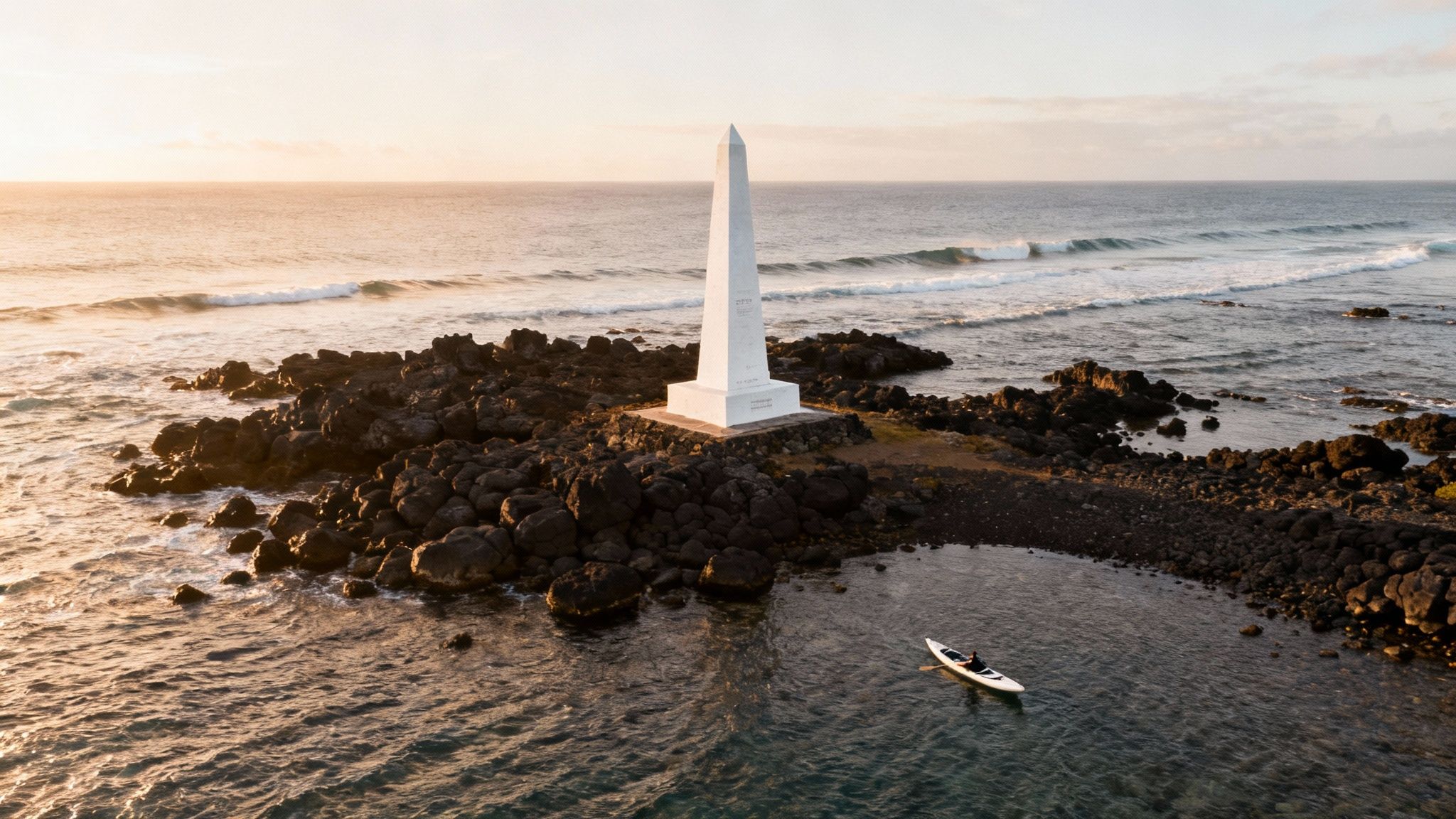
The best tour guides are more than just crew members; they're storytellers. They bring the bay's dramatic past to life, connecting you to the events that unfolded here centuries ago. This historical context enriches every moment, giving you a deep appreciation for why this tour is so unique.
The Makahiki Festival And A Fateful Arrival
Captain James Cook’s arrival in 1779 was a moment of incredible, almost unbelievable, timing. He sailed into Kealakekua Bay right in the middle of the Makahiki festival, a sacred season lasting for months dedicated to Lono, the Hawaiian god of fertility, peace, and agriculture. During this period, all warfare was forbidden (kapu), and the islands were immersed in celebration.
Cook's enormous ships, with their tall masts and striking white sails, happened to look a whole lot like the symbols associated with Lono. Because of this, many Native Hawaiians initially saw him and his crew as divine beings. The welcome was peaceful and filled with reverence; Cook was showered with honors and provisions.
The initial encounter at Kealakekua Bay was one of awe and respect, rooted in deep spiritual beliefs. It represents a fascinating intersection of cultures, where ancient prophecy and modern exploration met in one of the world's most beautiful settings.
But this peaceful welcome wasn't meant to last. After leaving the bay, one of Cook's ships suffered a broken mast, forcing an unexpected and ill-fated return for repairs. This second arrival broke with the prophetic timing of the first, planting seeds of doubt and creating tension between the islanders and the crew.
From Welcome To Conflict
The whole vibe in the bay shifted dramatically. What began as a harmonious exchange soured as cultural misunderstandings and arguments over resources escalated. The once-divine visitor was now seen as a mortal man, and the relationship between the Hawaiians and the British sailors grew strained.
This is the historical turning point that your tour brings you face-to-face with. Relations deteriorated quickly, culminating in Cook’s violent death at the bay on February 14, 1779. It happened after he tried to kidnap a high-ranking chief in retaliation for a stolen boat. You can get the full story and its impact by reading more about the historical context of your snorkel tour on konasnorkeltrips.com.
Today, any good tour approaches this history with the respect it deserves, sharing the story from both Hawaiian and Western perspectives. This balanced storytelling is crucial for understanding the full weight of what happened here.
The Monument And Its Lasting Legacy
While you're snorkeling, you can't miss the striking white obelisk on the shoreline—the Captain Cook Monument. This 27-foot structure was put up in 1874 and marks the approximate location where Cook died. In a unique historical arrangement, the small piece of land it sits on was deeded to the United Kingdom, so it's technically a tiny slice of British territory on American soil.
The monument stands as a silent witness to the events that forever linked this serene bay with a pivotal moment in global history. It acts as a visual anchor, connecting the beautiful underwater world with the complex human story that played out on its shores. Understanding this rich history adds a powerful dimension to your Captain Cook snorkel tour, making it an unforgettable exploration of both nature and the past.
Exploring the Underwater World of Kealakekua Bay
This is the main event. Slipping into the calm, protected waters of Kealakekua Bay feels like entering another dimension. It’s a silent, vibrant world where the only sound is your own breathing and the gentle crackle of parrotfish nibbling on coral.
This isn't just any old snorkel spot; it's a protected Marine Life Conservation District. That special status has allowed it to become a bustling underwater metropolis, teeming with life.
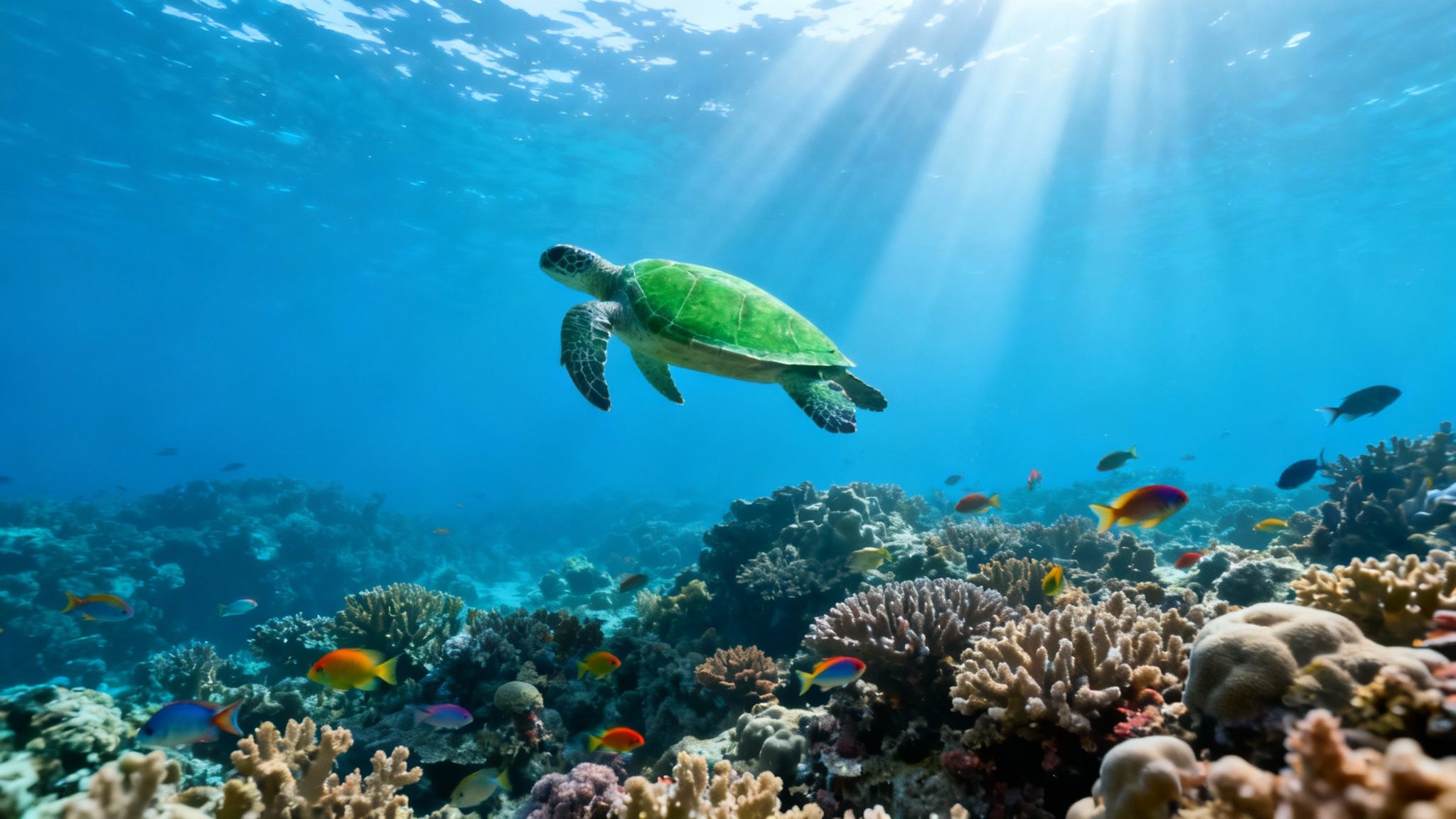
The clarity of the water here is legendary. On most days, you can easily see over 100 feet down, giving you the sensation of flying over a submerged landscape. One moment you're floating through a shimmering cloud of yellow tang, the next you’re watching playful spinner dolphins leap in the distance. The bay’s protected status is the secret sauce behind its healthy, diverse coral reef system—the very foundation for everything you’re about to see.
A Sanctuary Teeming With Life
Every single trip into the bay is a little different, but the cast of characters you're likely to meet is consistently spectacular. This sanctuary is home to some of Hawaii’s most iconic and beloved marine animals, and you’re not just looking at fish; you’re a quiet visitor in their thriving world.
Here’s a quick preview of the locals you might run into:
- Honu (Hawaiian Green Sea Turtles): Seeing these ancient, graceful creatures is always a highlight. You'll often spot them gliding effortlessly over the reef or resting peacefully on the sandy bottom—a truly revered sight in Hawaiian culture.
- Naiʻa (Spinner Dolphins): The bay is a crucial resting spot for these acrobatic mammals. While we can't interact with them (it's for their own protection), watching their pods from a respectful distance on the boat is an experience you won't soon forget.
- Vibrant Reef Fish: Get ready for a visual overload. The reef is buzzing with countless species, including brilliant yellow tangs, parrotfish (uhu) munching audibly on coral, delicate butterflyfish, and of course, Hawaii’s state fish, the famously named humuhumunukunukuāpuaʻa.
This explosion of life didn't happen by accident. The health of Kealakekua Bay is a direct result of its protected status, making your snorkel experience a look into one of Hawaii’s most precious and successfully preserved natural treasures.
Why The Bay Is So Clear And Healthy
The bay’s unique geography is a big part of the magic. It’s naturally shielded from the open ocean’s rough swells, which creates the calm, clear conditions that are just perfect for snorkeling. That natural protection, combined with its conservation status, allows fragile coral gardens to flourish without the pressure of fishing or heavy boat traffic.
This pristine environment attracts an incredible density of marine life, drawing over 190,000 visitors a year and making it one of Hawaii's absolute best snorkeling destinations. Its designation as a Marine Life Conservation District is the key to maintaining that crystal-clear water and supporting a thriving ecosystem with over 200 species of fish. This careful management is what makes your tour feel like a journey into an untouched paradise.
Your Role In Protecting This Paradise
As amazing as it is to explore Kealakekua Bay, it's just as important to be a good guest. The health of this underwater world depends on every single visitor acting as a respectful observer. Your tour crew will give you the full rundown on best practices, but it all boils down to a few simple rules.
These rules are simple but incredibly important:
- Keep Your Distance: Never chase or try to touch marine animals. Just admire them from a respectful distance so they can go about their day undisturbed.
- Don't Touch The Coral: It might look like a rock, but coral is a living, fragile animal. Even a light touch can damage or kill it, which hurts the entire reef ecosystem.
- Use Reef-Safe Sunscreen: Many common sunscreens contain chemicals like oxybenzone that are toxic to coral reefs. Always choose a mineral-based sunscreen to protect both your skin and the ocean.
By following these guidelines and other marine environmental protection tips, you become a partner in preservation. Your mindful presence helps ensure this underwater paradise stays pristine for generations to come, allowing others to have the same jaw-dropping moment you’re about to experience.
How to Choose the Perfect Captain Cook Snorkel Tour
Picking the right company for your Captain Cook snorkel tour is a lot like choosing a restaurant for a special night out. Are you in the mood for a lively, social spot with all the bells and whistles, or do you prefer a quiet, intimate experience that's all about the main course? Every tour operator brings a different flavor to the table, and knowing what you're hungry for is the secret to a perfect day.
The operator you choose really does shape the entire experience, from the vibe on the boat to the size of the crowd you're with. Some tours use smaller, zippier boats that feel like a private charter. Others run big, stable catamarans that are more like a party on the water, often decked out with waterslides and a full lunch spread. Neither is better than the other; they just cater to different kinds of adventurers.
Big Boat Fun or Small Group Intimacy
The biggest fork in the road comes down to the boat and how many people you'll be sharing it with. A larger vessel, like a spacious catamaran, usually means more room to move around, onboard bathrooms, and a smoother ride. This makes them a fantastic pick for families with little ones or anyone worried about seasickness. These trips are built for comfort, fun, and mingling.
On the flip side, a smaller boat tour offers a much more personal adventure. With fewer passengers, you get more face time with the crew, who are typically bursting with incredible stories and local knowledge about the bay's history and the fish you're seeing. These tours feel less like a cruise and more like a true expedition.
The real question to ask yourself is this: Do I want a social experience with lots of amenities, or am I looking for a quiet, focused journey into the heart of Kealakekua Bay? Your answer will instantly help you narrow down your options.
Deciding on your ideal group size is the first major step. A smaller group usually means a quicker check-in and more hands-on attention from the guides, while a bigger group can have a more festive, party-like atmosphere. Both paths lead to the same mind-blowing snorkeling, but the journey there will feel completely different.
Comparing Your Tour Options
So, let's break down what different companies bring to the table. The Captain Cook snorkel tour scene on the Big Island is a cornerstone of local ecotourism, with operators catering to all kinds of tastes. A quick look at the market shows a healthy variety: tour durations typically run from 3 to 5 hours, group sizes range from intimate (6–12 people) to large (20–40), and prices usually fall between $90 and $220 per person, depending on what's included. You can get more great insights into the local tour market on konahonudivers.com.
To make it even easier, I've put together a table comparing the main styles of tour operators. This should help you zero in on your perfect match.
Captain Cook Snorkel Tour Operator Comparison
Choosing the right boat style is the key to crafting your ideal day on the water. This table compares the most common tour types to help you find the one that fits your travel style.
| Tour Type | Typical Boat Style | Average Group Size | Common Amenities | Best For |
|---|---|---|---|---|
| Intimate Tours | Smaller Powerboats | 6–20 guests | Snorkel gear, expert guides, snacks & drinks | Travelers seeking personalized attention and in-depth education about marine life and history. |
| Catamaran Cruises | Large Catamarans | 20–40+ guests | Lunch buffet, bar, waterslides, restrooms, ample shade | Families, social groups, and anyone who wants a comfortable, relaxing day with plenty of fun amenities. |
| Adventure Tours | Zodiac-style Rafts | 6–16 guests | Fast-paced ride, minimal amenities, snorkel gear | Thrill-seekers and adventurous snorkelers who want to explore sea caves and the coastline quickly. |
At the end of the day, whether you pick a zippy raft or a luxurious catamaran, you're heading to the same spectacular destination. The trick is to choose the ride that makes the journey there just as memorable.
Morning vs. Afternoon Departures
Another key decision is timing. Most companies offer both morning and afternoon departures for their Captain Cook snorkel tour, and each has its own distinct perks.
Morning tours are, by far, the most popular choice, and for good reason. The ocean is usually at its calmest and clearest in the morning before the afternoon trade winds kick up. That translates to a smoother boat ride and better underwater visibility—prime time for snorkeling.
Afternoon tours, however, are a great option if you prefer a more relaxed start to your day. While the water might have a little more surface chop, the crowds in the bay have often thinned out, which can make for a more peaceful snorkel session. Plus, the afternoon sun casts a beautiful golden glow over the Kona coast on the ride back.
No matter which you choose, the marine life in Kealakekua Bay is active all day long. Your decision really comes down to personal preference: an early start for the calmest conditions, or a later departure for a more laid-back pace.
What to Pack for Your Snorkeling Adventure
A little prep work goes a long way to making sure your Captain Cook snorkel tour is fun, comfortable, and completely stress-free. If you think ahead just a little, you can spend less time worrying and more time soaking it all in.
Your tour will cover the big stuff—the mask, snorkel, and fins. But bringing a few personal items can take your day from just good to absolutely perfect. Think of it like packing a small daypack for a hike; having the right gear means you're ready for whatever the ocean throws your way. You'll want to focus on sun protection, staying comfortable, and of course, capturing the memories.
Your Essential Pre-Trip Checklist
This isn't complicated. Nailing down these few must-haves means you can focus on the incredible underwater world of Kealakekua Bay instead of kicking yourself for forgetting something.
-
Reef-Safe Sunscreen: This is a big one, and it's non-negotiable. Many common sunscreens have chemicals like oxybenzone and octinoxate that are incredibly harmful to our coral reefs—so much so that Hawaii has banned their sale. Always grab a mineral-based sunscreen that uses zinc oxide or titanium dioxide. It's the only way to protect both your skin and the delicate ecosystem you came to see.
-
Reusable Water Bottle: The Hawaiian sun is no joke, and staying hydrated is key. Most tours have water, but bringing your own reusable bottle is a great way to cut down on plastic waste and make sure you always have water on hand.
-
Towels and a Change of Clothes: Trust me, you'll be so happy to have a dry towel waiting for you after your swim. And slipping into a dry set of clothes for the boat ride back to the harbor is one of those simple comforts that makes a huge difference.
-
Underwater Camera: You're about to see some amazing sights. A GoPro or a similar waterproof camera is perfect for snapping photos of the colorful schools of fish, wild coral formations, and maybe even a sea turtle cruising by.
-
Sun-Protective Gear: The sun reflecting off the water is intense. A wide-brimmed hat and a good pair of polarized sunglasses will be your best friends on the boat. They'll give your eyes and skin a much-needed break between dips in the water. For a deeper dive, our guide on what to wear for snorkeling has plenty of other tips.
What to Expect on Tour Day
Knowing the flow of the day helps get rid of any pre-trip jitters. When you show up, the check-in is usually quick and painless. The crew will greet you, have you sign a standard waiver, and get you fitted for gear to make sure your mask has a good seal.
Before you even leave the harbor, your guides will run through a full safety briefing. This is honestly one of the most important parts of the entire Captain Cook snorkel tour.
Your crew members are lifeguard-certified pros who know these waters inside and out. They’ll cover everything from how to clear your snorkel to what marine life to look for, so pay close attention. Their main job is to make sure you feel totally safe and confident before you hit the water.
Tips for First-Timers and Anxious Snorkelers
It’s completely normal to feel a little nervous, especially if this is your first time. The good news is that the calm, protected waters of Kealakekua Bay are the ideal spot to learn. We always have flotation devices like pool noodles and life vests available to help you float effortlessly.
If you’re prone to seasickness, you might want to take a non-drowsy motion sickness pill before you get on the boat. It also helps to drink plenty of water and keep your eyes fixed on the horizon during the ride out. The crew has helped countless first-timers and will give you all the support you need to have an incredible experience.
Sights to See Along the Kona Coastline
The boat ride to Kealakekua Bay is way more than just a commute—it's an adventure all on its own. Your Captain Cook snorkel tour really begins the moment you leave the harbor, because what you see above the water is just as mind-blowing as what's below.
As the boat heads south from Kona, the coastline opens up like a live-action geology lesson. It's a rugged, dramatic landscape carved out by thousands of years of volcanic fury. This isn't just killing time until you get to the snorkel spot; it's a front-row seat to Hawaii's creation story.
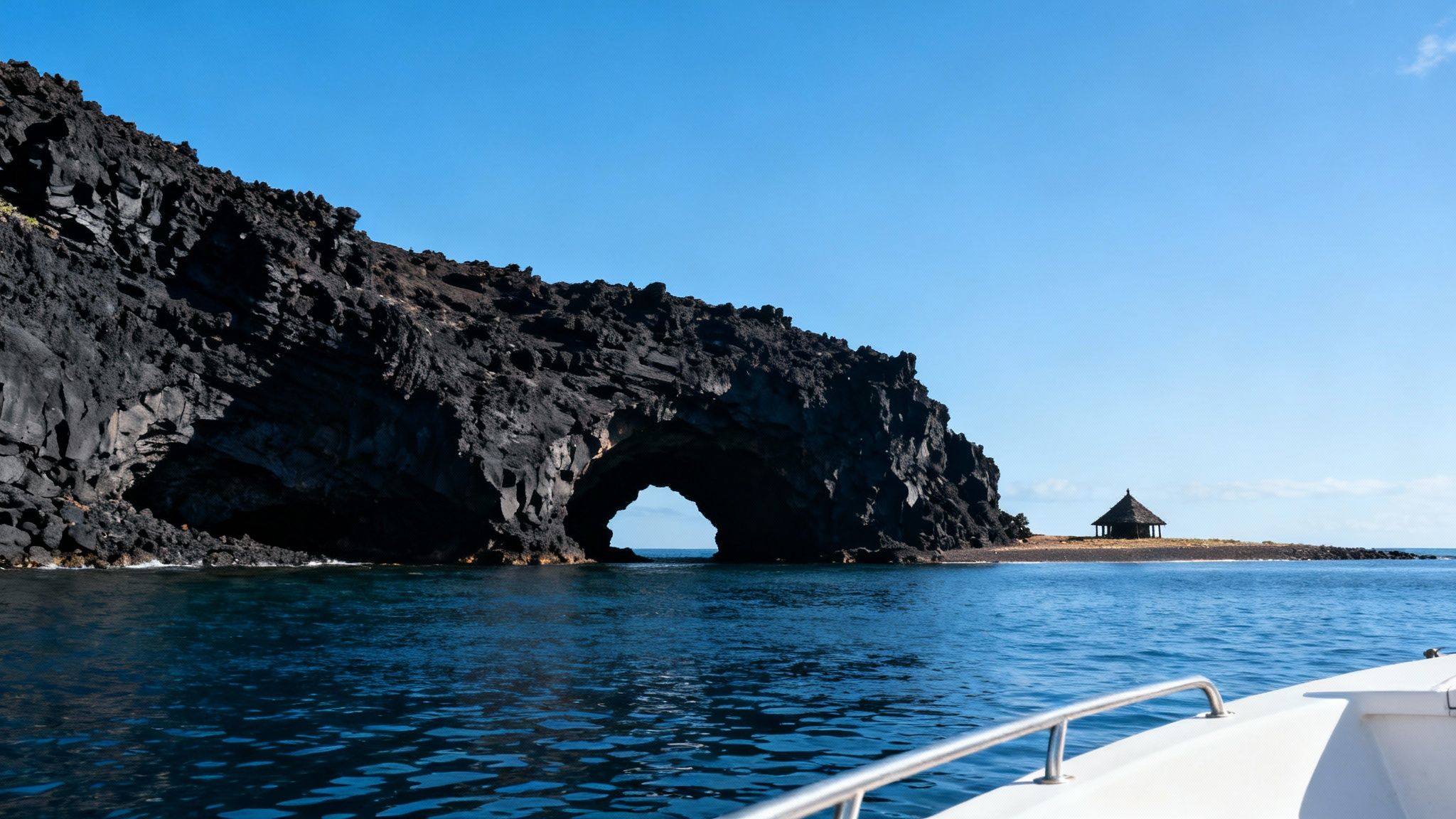
Most captains double as fantastic guides, pointing out the incredible formations that make this stretch of coast so unique. You'll want to keep an eye out for ancient lava flows, frozen solid as they reached for the brilliant blue Pacific. These raw, jagged landscapes tell the story of the Big Island’s fiery birth.
Lava Tubes and Sea Caves
Some of the coolest features you'll spot are the countless sea caves and lava tubes that pockmark the shoreline. These things are wild. They formed when molten lava rivers flowed toward the ocean. While the outside of the flow cooled and hardened into a crust, the fiery river inside kept moving, eventually draining out and leaving a perfect, hollow tube behind.
Over centuries, the relentless push and pull of the ocean waves smashed into these formations, carving out the dramatic sea caves and arches you see today. If the ocean is calm, your captain might even nose the boat in for a closer look. They're a powerful, humbling reminder of the volcanic forces that built this island from the ocean floor up.
The trip down the Kona coast is a huge part of the experience. It sets the stage for the natural and historical wonder of Kealakekua Bay, giving you a much deeper appreciation for this special place.
Ancient Hawaiian Landmarks
Beyond the incredible geology, this coastline is steeped in cultural history. As you get closer to Kealakekua Bay, your guide will likely point out important historical sites you can see right from the water. One of the most significant is the Hikiau Heiau, a sacred Hawaiian temple right on the shore, directly across the bay from the Captain Cook Monument.
This heiau was a major place of worship dedicated to the god Lono, and it was in active use when Captain Cook first arrived. Seeing it from the boat adds a whole new layer to the story of the bay, connecting your snorkel trip to the deep spiritual heritage of the area.
By the time you drop anchor, you’ve had a full-blown geological and cultural tour. You'll have a much richer understanding of the magnificent landscape and the powerful stories it holds, which makes the whole day feel that much more special.
Your Top Questions Answered
We get a lot of questions about the Captain Cook snorkel tour, and we want to make sure you feel totally ready for the adventure. Here are some quick answers to the things people ask most, covering everything from swimming skills to the best time of year to visit.
Do I Need to Be a Strong Swimmer?
Not at all. The tour boats are fully equipped for every skill level, and they always provide flotation gear like pool noodles or vests to help you relax in the water.
Kealakekua Bay is naturally sheltered, so the water is usually incredibly calm—perfect for just floating on the surface and watching the fish swim below. Just give your crew a heads-up if you're new to snorkeling. They're great at offering a little extra help and guidance to make sure you feel completely comfortable. For a deeper dive, check out our guide on essential snorkeling safety tips before you go.
What Is the Best Time of Year for This Tour?
Honestly, any time is a great time! Kealakekua Bay is blessed with fantastic snorkeling conditions year-round because it's so well-protected from big ocean swells.
That said, we usually recommend the morning tours. The water is at its calmest and clearest then, before the afternoon winds have a chance to pick up.
Here's a pro tip: If you book your tour during the winter months (December through April), you might just get a bonus show. It's humpback whale season, and spotting these majestic creatures on the boat ride is an absolutely magical addition to the day.
Can I Get to the Captain Cook Monument by Land?
Technically, yes, but we really don't recommend it. There's a path called the Kaʻawaloa Trail, but it's a seriously tough hike. You're looking at a hot, difficult trek over rugged lava rock with an elevation change of more than 1,200 feet.
The easiest, safest, and by far the most enjoyable way to see the monument and experience the incredible snorkeling is on a licensed boat tour. You'll get all the gear you need, professional safety oversight, and the rich historical stories that make the Captain Cook snorkel tour a truly special experience.
